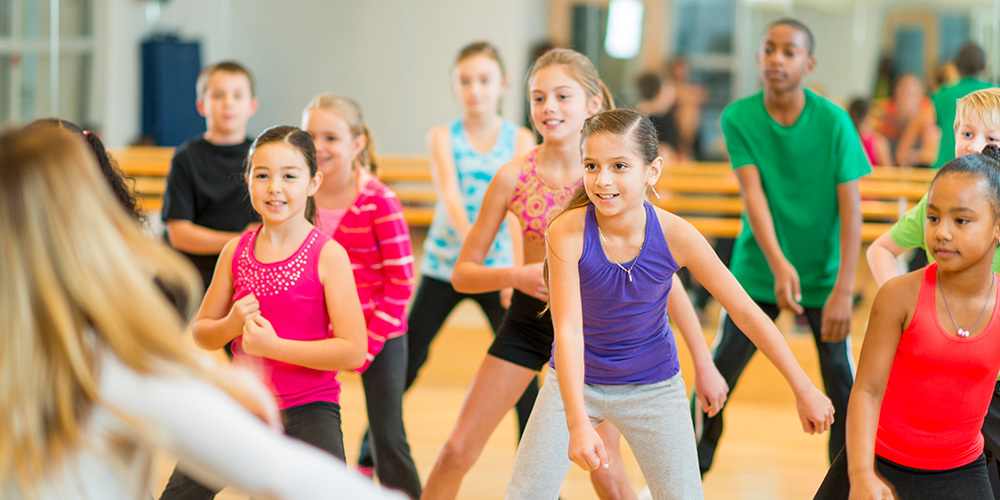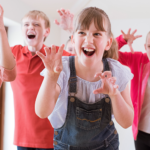Dancing is fun. But unlike certain other fun activities like playing video games and eating cookies, dancing has enormous physical and mental benefits for students’ development. Brain scans in multiple studies have shown that dancing involves a complex coordination of several brain regions and can strengthen a range of skills such as motor control, hand–eye coordination, memory, and more.
In this article, we’ll explore the benefits of using dance in your PE class, as well as some dances you can introduce in your gym today.
The Physical, Mental, and Social–Emotional Benefits of Dance
The physical and mental benefits of dance cannot be overstated. Dance improves cardiovascular health, heightens balance and strength, boosts cognitive performance, and provides stress relief, all with low wear and tear on the body. Let’s look at a few of these benefits in more detail.
Physical
- Dancing is a great cardio activity. The Department of Health and Human Services recommends 150–300 minutes of moderate exercise or 75–150 minutes of vigorous aerobic activity per week. Depending on the type, dance can easily fulfill either of these requirements, and make the time go by quickly too!
- Dancing helps with balance and strength. Dance movements often tap into muscles and movements we don’t typically use for daily activities, so practicing these motions can help improve our ability to balance and build up little-used muscle strength.
- Anyone can dance. That doesn’t mean everyone is good at dancing. Rather, dancing is an exercise that people of all ages and physical abilities can participate in. Many forms of dance are easy on the body, so even people with limited mobility or ongoing pain and injuries can learn the steps and take advantage of dancing’s many benefits.
Mental
- Dance enhances your cognitive performance. The brain needs oxygen and energy to function well, and dance helps your body produce both. Dance can also teach students to focus and be more creative and disciplined, which are useful skills in any mental endeavor.
- Dance is mentally challenging. Unlike some other forms of exercise, dance engages the brain on many levels: You have to remember the steps, know how to shift from one movement into another, stay coordinated with the music and other people, and maintain balance while doing all these things.
Social–Emotional
- Dancing is social. Studies show that dance taps into the same cooperative movements required in sports and playing music together. During dance, people begin to emit the same low-frequency brain waves, demonstrating the connection between participants.
- Dancing improves your mood. Like many other forms of movement and exercise, dance has been shown to reduce stress, decrease anxiety and depression, and boost self-esteem. It turns out dance breaks are a legitimate form of study break, after all.
Dance Exercises: The Classics
The Chicken Dance
In the 1950s, while working as an accordionist at a ski resort, Swiss musician Werner Thomas had a catchy little melody pop into his head. As he tinkered with the music, Thomas noticed that the skiers coming down the slopes reminded him of a bird; their hand gestures looked like a beak, the way they held their poles looked like a bird flapping its wings, and their skis looked like waddling feet. Thus, the seeds of “The Chicken Dance” were born.
Originally, the song was called “Der Ententanz” (“The Duck Dance”) and later became “Dance Little Bird.” It earned the moniker “The Chicken Dance” in the U.S. thanks to an Oktoberfest event in Tulsa in 1981. A German band wanted to teach the dance to the crowd but couldn’t find a duck costume—only a chicken suit. To this day, no wedding, bar mitzvah, or sports event can resist the allure.
The Macarena
Spanish group Los Del Rio wrote “The Macarena” after they watched the beautiful movements of flamenco dancer Diana Patricia Cubillán Herrera. The song quickly swept across the world and became a hit in the U.S. when the Bayside Boys did a half-English, half-Spanish remix of the song. We’ve all had it stuck in our heads ever since.
The dance is simple enough that students will easily be able to pick up the movements. Add to the workout by having students bounce to the beat of the song as they do the arm movements.
Note that the original Spanish lyrics of “The Macarena” include sexual references, so below, we’ve embedded both the original and a kid-friendly version.
Y.M.C.A.
In the late 1970s, the Village People were almost finished with their third album but needed one more song to fill out the tracklist. In less than 20 minutes, Jacques Morali wrote the music and an outline for the lyrics of what would become “The Y.M.C.A.” The tune sounded so much like a commercial jingle that the group thought it might catch on. They were right. When the Village People performed the song on the show American Bandstand, fans were so into it that they created the famous arm motions on the spot, and the gestures have stuck ever since.
To add some rigor to this dance, have students do a marching step throughout the song.
The Cha Cha Slide
“The Cha Cha Slide” taps into many of the benefits of dance discussed above, including the mental challenge of hearing and following the steps, and the physical benefits of balance and coordination. It’s no surprise that this dance is great for exercise because it started as the project of a fitness trainer in Chicago. David Wilson was looking for a fitness routine for his aerobics class, and enlisted the help of his uncle, popularly known as DJ Casper. The first version of the song existed only as a self-produced track Wilson used in his classes, but it became so popular that Casper recorded a new version of the song. This became “The Cha Cha Slide” we all know and love (or at least tolerate).
The Hokey Pokey
For such an innocuous song, “The Hokey Pokey” has a mysterious and disputed origin:
- 1800s: Some say that “hokey pokey” is a play on the phrase “hocus pocus”—which, despite its modern associations with magic, comes from a line in the Latin Catholic Mass (“hoc corpus meum,” or “this is my body”). There are records of rhymes and minstrel songs throughout the early 1800s that describe dances similar to what we now know as “The Hokey Pokey.”
- 1857: Two sisters from Canterbury, England, traveled to New Hampshire and taught the locals a song with the lyrics “I put my right hand in / I put my right hand out / I give my hand a shake, shake, shake / And I turn myself about.” Although the song was set to a much slower tune than we know today, it’s hard to deny the similarities.
- 1942: While entertaining Canadian troops stationed in London, Irish songwriter Jimmy Kennedy created a song and accompanying dance he called “The Hokey Cokey.” In the very same year, composer Al Tabor, who was also entertaining Canadian troops in London, wrote a song and dance called “The Hokey Pokey.” The dances were very similar to one another, but both men claimed theirs was original.
- 1946: Four years later, without YouTube to make them aware of Kennedy and Tabor’s “Hokey” songs, Scranton, PA, natives Robert Degan and Joe Brier recorded a song they called “The Hokey-Pokey Dance.” These two were aiming to entertain vacationers at the Poconos rather than soldiers, and it became a regional favorite.
- 1949: In an eerily similar account in Idaho, Charles Mack, Taft Baker, and Larry Laprise wrote and recorded a song called “The Hokey Pokey” to entertain skiers at the Sun Valley Resort. Degan and Brier sued the other group for copyright infringement, but Mack, Baker, and Laprise won. It was later re-recorded and became the version we know today.
Regardless of where the song came from, with the right amount of enthusiasm, “The Hokey Pokey” can be a fun exercise for your students






